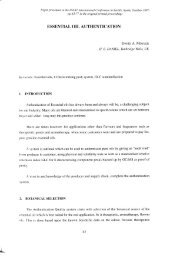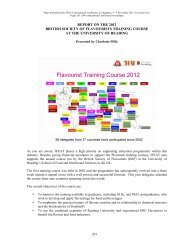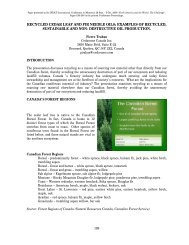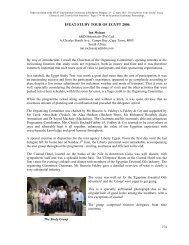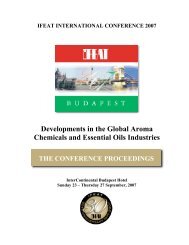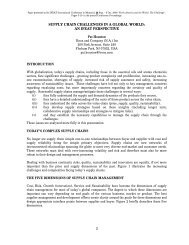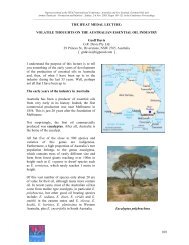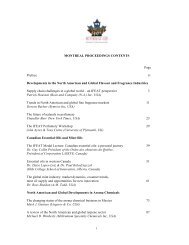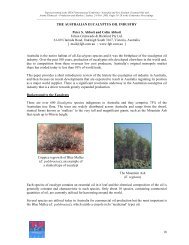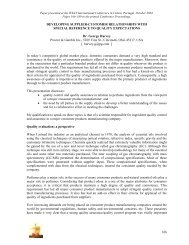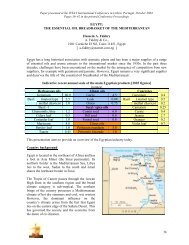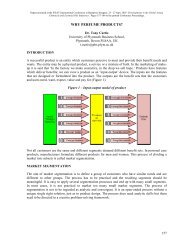ON THE SCENT OF SOUTH AFRICAN ESSENTIAL OILS: - IFEAT
ON THE SCENT OF SOUTH AFRICAN ESSENTIAL OILS: - IFEAT
ON THE SCENT OF SOUTH AFRICAN ESSENTIAL OILS: - IFEAT
You also want an ePaper? Increase the reach of your titles
YUMPU automatically turns print PDFs into web optimized ePapers that Google loves.
Paper presented at the <strong>IFEAT</strong> Int. Conference in Cape Town, South Africa, 27 Nov.- 1 Dec. 2006: ‘The Industryin Sub-Saharan Africa and the Indian Ocean Islands’. Pages 172-184 in the printed Conference Proceedings._________________________________________________________________________________The <strong>IFEAT</strong> Medal Lecture:<strong>ON</strong> <strong>THE</strong> <strong>SCENT</strong> <strong>OF</strong> <strong>SOUTH</strong> <strong>AFRICAN</strong> <strong>ESSENTIAL</strong> <strong>OILS</strong> -AN EVENTFUL JOURNEYEarle H. GravenGrassroots Group (Pty) Ltd.P.O. Box 16, Gouda 6821, South Africa( ugraven@global.co.za )I have been asked to talk about my career against the background of the South African essential oilindustry. First, however, I would like to emphasize that I have always worked with a team and that anyachievements must be credited to the whole group.Like my maternal grandfather, I was born and spentpractically my entire career in the Eastern Cape. Hisfather was one of the German mercenaries who weregiven land in the Eastern Cape by Queen Victoriaafter the Crimean War. My grandfather was a ruggedfrontiersman who was fluent in isiXhosa, thelanguage of the local inhabitants. Like them, he wasfamiliar with all the aromatic medicinal plants of theveld – an interest that I absorbed on my walks in theveld with him. Even today the Xhosa plant namescome more easily to me; e.g. Inzinziniba for Lippiajavanica, Mhlonyana for Artemisia afra and NukaNuka for tagette.South Africa played a significant role in World War II on the side of the Allies and when the soldiersreturned in 1945, General Jan Smuts - an acknowledged world statesman of the time - was the PrimeMinister of South Africa. He was an accomplished biologist and was greatly concerned with soilerosion and the deterioration of the ecological environment. He used his influence to introduce specialuniversity degrees in soil conservation and forestry for the returning ex-servicemen. This had farreachingconsequences for the agricultural industry of this country and influenced me to go in thesame direction.My first post after graduating was as an agronomist at the Dohne Research Institute, where Ideveloped a passionate interest in plant nutrition. In the process I ran collaborative experiments onfarms all over the Eastern Cape and became very familiar with the people, the ecology and the farmingpractices of the area. I found that most of the agricultural problems related to the acute shortage ofplant nutrients in South African soils, particularly phosphorus.This experience proved to be very valuable in later years when we started growing our own essentialoil crops. Indeed, lack of adequate fertilization is a major reason why so many local essential oilprojects have floundered.It has been said that under most South Africa conditions, growing crops without adequate fertilization,is like teaching someone to swim with a 25 kg weight around their necks.172
Plots with and without phosphorous Molybdenum deficiency Sulphur deficiencyIn the course of this research, I spent three years at the University of Wisconsin, U.S.A. where I wasforce-fed the basic sciences, in particular plant and soil chemistry, in order to obtain my Ph.D degree. Ireturned to South Africa at a time of great political upheaval because of the rigid application ofApartheid. The country was in turmoil. Many of our finest scientists were leaving the country. I toowas seriously considering this step when the University of Fort Hare in the Eastern Cape invited me tohelp establish a Faculty of Agriculture at their campus in Alice.At the University of Fort HareThe University of Fort Hare was the first, and fora long time, the only university in Sub-SaharanAfrica which catered for tertiary education forBlack students. It has been referred to as the‘Crucible of African Leadership’ and can count asits alumni many of the present and ex-leaders ofAfrican states; e.g. our revered ex-PresidentNelson Mandela, Govan Mbeki, Oliver Thamboand many others.I had grown up in the Eastern Cape, loved thearea and its people and was well acquainted withthe agricultural sector. My wife and I decided thatthis was our chance to do something positive. Theprospect of training truly competent agriculturistsfrom the disadvantaged section of the communityseemed to be a worthwhile task.I started at Fort Hare in January 1970. Under theApartheid Government, the university was,initially, strictly for Black students only. In thecourse of the next few years the restrictions wereprogressively relaxed and the Faculty ofAgriculture at Fort Hare gathered together one ofthe finest teams of agricultural scientists in thecountry. I am indeed very proud to have been partof this team and to have retained my contactswith the University.Univ. of Fort Hare Clock Tower173
Discovering a new world of essential oilsIn this new environment, my career made a switch from academic training of graduate students to theidea of developing unique strategies for rural development and alleviation of poverty. This became anobsession. When Mr Siegfried Piprek, a German ex-cavalry officer, was appointed manager of theresearch farm, I was immediately intrigued by the fact that he was passionate about essential oils.These unconventional crops seemed to offer a unique opportunity for rural development and started usoff on the serious exploration of plant essential oils. Sadly, in 1979, just when the project was poisedfor success, Siegfried was tragically killed in a motor accident.Apart from the work by Dr Blommaert (on buchu in the 1950s), Dr Garbers (on tagette in the early1970s), Dr van Gelde (on peppermint) and Dr Derek Donald (on eucalypts), little formal research onessential oil production has been done in South Africa.As a first step I made contact with the Rolan Essential Oils company which was the only significantessential oil producer - eucalyptus and citrus oils excepted - in South Africa at that time and therecommenced a relationship of close cooperation which has lasted for 20 years.REO, the pioneers of the South African essential oil industry was established in the late 1960s byMessrs Roland de la Harpe, Yanni Yanoulatis and Mark Lilford. Mr Yanoulatis was an essential oilexpert of repute who, although of Greek origin, learned his trade in Egypt. He is understood to haveplayed a significant role in the development of cassie oleoresin (Acacia farnesiana). Comprehensivetest plots of practically all known essential oil crops were established. Commercial plantations ofSeville orange, cassie, jasmine, tuberose and other aromatic crops were established on their farm nearRustenburg. They were very helpful and forthcoming with advice and we exchanged ideasenthusiastically. At their headquarters in Rustenburg, they constructed formidable distillation andextraction facilities which even 20 years later were still state of the art. Sadly, in the mid-1970s, REOexperienced insurmountable financial difficulties that led to insolvency. During the course of the next15 years, the company was taken over at discounted prices by a number of successive companies, eachof which was optimistic about re-vitalizing the essential oil industry. In the late 1980s, REO wasacquired by a subsidiary of the South African Industrial Development Corporation (SAPECO). Theyhad great initial confidence in the industry and made substantial investments in additional farmingproperties in other ecological areas. They established large commercial plantations of paprika andgeranium as well as comprehensive test nurseries with the view to identifying other profitablearomatic crops.By the early 1990s it was apparent that the project was once again in trouble and in 1992 I wascommissioned to conduct an assessment of the project and to make recommendations. I contracted DrNicholae Provatoroff who had recently retired from Naarden-Quest to assist me in this task.Essentially REO’s problems related to the fact that they produced niche products without having firmorders and did not have a bread-and-butter product that could cover their overheads. The situation wasexacerbated by the difficulty of marketing South African products during the period when SouthAfrica was subject to sanctions because of the Apartheid regime.During this same time period numerous other essential oil projects sprang up all over the country,producing a very wide range of essential oil crops, ranging from vetiver to Australian tea tree oil.None of these appeared to have attained any notable success until the mid-1990s. As one of the fewreasonably experienced local essential oil specialists, frequently I was called upon by prospectiveessential oil producers for advice. In the eyes of the inexperienced, the essential oil business is - as oneprospective grower declared, ‘Very sexy’ - and my advice that small-scale tests and economic analysis174
should precede commercial production was not generally popular. Some life-savings were lost inprojects based on plants from local nurseries that had only the name in common with the genuineessential oil species.Essential oils research at the University of Fort Hare (1970-1991)Initially, the research programme concentrated mainly on the evaluation and small-scale testproduction of conventional essential oil crops. Comprehensive test nurseries were established in threedifferent ecological rural areas of the Eastern Cape. At each site as many as 20 different essential oilcrops were evaluated as to their adaptability to the region and their economic viability. In theeconomic climate prevailing at that time, it appeared that only peppermint, geranium and basil had adegree of economic merit.Field trials at Fort Hare:Peppermint Basil GeraniumPeppermint appeared to have the most promise with yields of 45 kg / ha and an acceptable chemicalprofile which closely resembled Wayne County quality. Unfortunately it was found that unseasonablerain at harvest time made it a very risky crop in the Eastern Cape. Subsequent work done by DirkBosman in the Western Cape confirmed that quality peppermint could be produced in South Africa.However, it apparently does not compete well with other crops having lower economic inputs.Concurrently with the research on conventional oil crops, the team enthusiastically collected, distilledand analyzed the indigenous aromatic plants of the Eastern Cape. We hoped to discover new crops thatcould be used as a vehicle for rural development. Most of the crops studied are aromatic weed-like,pioneer species that are costly to eradicate. In essence this means that, if successful, liabilities can beconverted into assets.Lanyana:In the wildXhosa ladies with lanyanaleaves up their nostrilsCultivatedplot175
Lanyana (Artemisia afra) is South Africa’s most widely used native medicinal plant. It is traditionallyused for bronchial complaints (either as an infusion or by direct insertion of the leaves in the nostrils)and as a vermafuge to control intestinal parasites.The oil closely resembles that of armoise (Artemisia herba-alba), wormwood (A. absinthium) andother high thujone oils. In the mid 1980s, a shortage of armoise resulted in significant sales of lanyanaoil.Oil yields of up to 150 kg / ha can be harvested from well-managed A. afra plantations. It appears thatoil composition in A. afra is largely genetically determined. Analysis of the oil of 20 randomlyselected A. afra plants showed a very wide variation in chemical composition with the thujone (alphaand beta) ranging from as little as 5% to as much as 90%. It was found that the oil composition of aselected mother plant varied by less than 5% over four vegetatively propagated generations, indicatingthe value of mother plant selection and vegetative propagation.Tagette:Harvesting tagette ina tribal maize fieldCultivated plotMobile still usedfor tagetteTagette (Tagetes minuta) is one of themost abundant and troublesome weedsinfesting summer-growing crops inareas of South Africa. It was introducedinto South Africa from South Americavia horse feed during the Anglo-BoerWar in 1899-1902. South Africa iscurrently a major producer of goodquality tagette oil (approx. 5 tons perannum).Effect of Soil Nutrient Status on Tagette Oil CompositionField and pot experiments have shownthat tagette oil quality is dependentupon the soil fertility.Cape chamomile (Eriocephalus punctulatus) is one of only three known plant oils that have thecharacteristic dark blue-black colour of German chamomile oil (Matricaria recutica). The colourationin both oils is due to chamazulene and associated azulenic compounds. Cape chamomile is reminiscentof Roman chamomile (Chamaemelum nobile). Indeed the oil has certain chemical characteristics ofGerman chamomile and the fruity notes of Roman chamomile, hence the name of Cape chamomile.176
Cape chamomile:In flower The oil Cultivated plot at GoudaHistorically, Cape chamomile oil was first introduced to the essential oil industry by Rolan EssentialOils when it was hailed as the new oil of the 1970s by major European essential oil houses.Unfortunately the wild material that was used for the production of the first few kilograms of oil didnot recover after harvesting and the project was abandoned. Work was resumed later by the CENTOILproject. Older French and European perfumers are still familiar with this oil.The plant is not easily propagated by seed and we had to develop a propagation protocol using rootedcuttings from selected mother plants with superior oil quality. The survival of the plants in the fieldafter harvesting remained a problem. It was only after successful harvesting procedures weredeveloped by Gerard Hansford (Grassroots Group) that the crop now can be grown in plantations onour farm at Gouda.Blue Mountain sage (SalviaBlue Mountain sage:stenophylla) oil is producedfrom a particular species of thegenus Salvia which was foundto contain as much as 30% of astereo-isomer of alpha-epibisabololwhich is similar to thewell-known therapeutic skinagent found in Germanchamomile oil from Matricariarecutica. The oil has a straw-In flowerCultivated plot at Goudacolour and a fresh, herby andslightly camphoric top note. The name ‘Blue Mountain sage’ was coined by Robert Tisserand (thearomatherapy pioneer) who incorporated the oil into certain skin care cosmetics.Unfortunately, the orders for this oil were unable to be fulfilled because of political unrest in the ruralareas in the late 1980s. Today, the plant is not abundant in the wild and a cultivation protocol has beendeveloped.Zinziba (Lippia javanica) is well-known for its medicinalproperties and is widely used as a traditional tea. One of the majorcomponents in the oil of the Eastern Cape species of Lippiajavanica is ipsdienone, which has insect-repellent qualities thathave been the subject of a significant study at the University ofHeidelberg, Germany. The oil has a unique fragrance profile and islocally used as a cosmetic ingredient. Trial in Botswana 177
Pteronia (Pteronia incana) is a hardy, intrusive and inedible weedthat has invaded some 60,000 hectares of grazing land in theEastern Cape. Interest has been shown in this oil due to itsolfactory properties, which suggest dwarf pine, Siberian fir-leaf oil.Pteronia inthe veld The culmination of this work was the successful EINECS registration for the following local oils:Artemisia afra Lanyana 294-744-5 CAS 91745-71-0Eriocephalus Cape chamomile 305-084-5 CAS 94334-04-5punctulatusPteronia incana Pteronia CAS 96508-07-5Salvia stenophylla Blue Mountain sage 297-496-6 CAS 93572-64-6This registration was largely due to the efforts of Mr Jean Garnero and Mr Jean Martin of Robertet ofGrasse, France with whom we worked very closely.However, as pointed out by Geoff Davis in his <strong>IFEAT</strong> Medal Lecture, it is today extremely difficult toput new oils on the market. A standard for the oil has to be laid down by an authorized body that willnot publish a standard unless it is an item of trade. This is effectively stifling the development of newplant oils. I am convinced that, particularly in South Africa, there are a host of other new oils waitingto be developed.The CENTOIL (Ciskei Essential Oil) Project, 1982-87The University of Fort Hare had an excellent programme in which research and travel funds wereallocated in terms of peer-rated publications and this enabled me to travel widely and attendconferences, particularly the International Essential Oil Congresses, where I became acquainted withthe premier essential oil experts and researchers, many of whom collaborated enthusiastically in theinvestigation of relatively unknown plants. I was often surprised by their knowledge of African plants.In one instance when I took an oil sample of a rather rare aromatic plant collected on the banks of theTyumi river near Fort Hare, Brian Lawrence took one sniff and immediately identified it as Clausinaanisata from East Africa. I was dumbfounded.By 1980, it was considered that we had accumulated sufficient information on selected local aromaticplants to tentatively establish a commercially oriented project. For an agronomist such as myself, thefiscal responsibilities of running such a project constituted a nightmare and I enlisted the assistance ofthe Head of Department of Accounting, Prof. Brian Gardener who enthusiastically and competentlycontrolled the project’s finances.As the first step we successfully submitted a research proposal to the Anglo-American Corporation’sChairman’s fund which had shown a keen interest in rural development. In brief, we proposed toestablish a small, commercial distillery and test the economic viability of an indigenous essential oilenterprise. The construction of a commercial scale distillation plant and the identification anddevelopment of markets for the oils produced was an integral part of the investigation.178
In spite of the Anglo-American grant and limited financial backing by the University, we werehopelessly under-budgeted and did not have sufficient funds to buy new equipment or engageprofessional services. We realized that we would have to construct the distillery ourselves in theresearch farm workshop using any material we could lay our hands on. We scoured the countryside forstainless steel scrap and purchased three large stainless steel beer tanks in a sale to use as retorts. Weattended dispersal and auction sales to find stainless steel scrap that could be adapted. At that time theUniversity was renovating one of the hostels and they discarded a number of stainless steel urinals.We cut them up to fabricate the oil separator and to use as baffles in the condensers and they becamean integral part of the distillery and the butt of many jokes. It was not for nothing that I earned thenickname ‘Old Second-hand’.Although the University top management were not overtly enthusiastic about the project, it seemed tograsp the imagination of middle management who made available the services of the farm workshop,the science workshop, the GCMS facilities of the Chemistry Department and the assistance of theDepartment of Buildings and Grounds, which supplied the transport. Even people unconnected withthe project began reporting sightings of scrap stainless steel and some even fabricated parts for us afterhours.Then we had to find a site for the distillery. Logically it shouldhave been on the research farm but we had no money for a boiler.However, the university had built a new gymnasium and hadvirtually abandoned the old one, which was conveniently situatednext to the huge University boiler house that provided steam for theentire campus. Before anyone knew what was happening, we hadtapped into the university steam supply and sited our stills behindthe gymnasium where they could not readily be seen.On realizing that the old gymnasium was used only infrequently by a body-building club, we modifieda section of the changing rooms to serve as our oil dispensary. The body-builders began complainingabout the strong aroma until someone jokingly pointed out to them that they should be happy aboutinhaling plant steroids. The fragrance from the distillery pervaded the university campus. The studentsclaimed they could find their way back from the pub in town by following the smell. On one occasion,when we were in full production using steam 24 hours a day, we caused the students’ showers to runcold, thereby almost causing a riot.We had to design the plant from scratch but I had the benefit of visits to Dr Brian Lawrence’sMerryhill farm near Winston-Salem and various contacts with Dr Mans Boelens (Hydrodiffusion),Nicolae Provataroff and others. When Tim Denny of Tasmania visited us in 1991, he approved of thedesign though he considered it slightly over-designed. Though we appreciated his input, we did findsome difficulty in understanding his distillation theory.Although there was a plentiful supply of distillable material,procurement and transport to the distillery presented complexproblems of communication with rural communities, organizationof the harvesting and the provision of cash payments. Two localyoung men proved invaluable in this operation. Themba Gxotiweand Michael Stofile were part of the project right from thebeginning, starting with the construction of the stills, and theythrived on the excitement of the challenge. As respected membersof the local tribal community they were able to effectively organizeHarvesting day179
harvesting and collection. They used their family networks as well as the local radio station toannounce where and when they would be a collection on a particular day. Their coordination was soeffective that in some instances schools closed down for the day in order for the pupils to help harvest.These turned into gala occasions. The University provided a clerk to travel with them to control thecash payments.The passionate dedication of these two young men was illustratedon the occasion when they were returning to base in an old Fordtruck with a 10-ton load of tagetes and the linkage between theaccelerator pedal and the carburettor fell off and got lost. Nothingdaunted, they crawled down the hazardous Kat Berg pass withMichael perched on the fender manually operating the carburettoraccelerator and Themba steering and braking.As part of the agreement with Anglo-American we had confidently undertaken to generate income tothe value of R70,000 over a 3-year period by the sale of local oils. After this, the project was intendedto operate independently from funds generated by the sale of oils. In actual fact the oils producedduring the first three years realised R255,000. In toto, oils to the value of R760,000 (R4.2 million intoday’s currency) were produced and significant employment opportunities created in a number ofeconomically depressed rural areas.In 1987, the University Council decided that the production aspects of the project were not thefunction of the university and that the revenue-earning sector of the project should be privatised. Theproduction facilities along with my two faithful assistants were accordingly taken over by LITET(Labour Intensive Industries Trust), a subsidiary of Anglo American Corporation that had as itsobjective the generation of job opportunities and resource development in rural areas. With thesubsequent disbandment of LITET, Mr R.J. Davies (a Director of LITET) took over the project in hispersonal capacity.But these were difficult times politically and the execution of rural projects was not easy. Risingmilitancy made the growing and harvesting of crops in the rural areas a hazardous undertaking. Afteran initial flourish the project ran into difficulties. Ironically, firm orders were obtained for the localaromatic oils such as tagette, Cape chamomile, lanyana, Blue Mountain sage, Pteronia, etc. butproduction was not forthcoming. This legacy still dogs the sale of these oils today.I must again pay tribute to my great team, particularly to Prof. Brian Gardner, who kept our books andcontrolled the finances, Cedric Tutt my efficient technician and Themba Gxotiwe and Michael Stofile,my faithful field procurers and distillers. It is significant that when the production phase of the projectwas shut down, all four went on to successful careers in other fields. Brian Gardner became ActingVice-Chancellor of the University during the difficult transition period when the University was beingopened to all, Cedric Tutt became a successful veterinary scientist, Themba Gxotiwe a successfulbusinessman and Michael Stofile is today Vice-President of the South African Rugby Board.Continuation of research, 1987-1992After suspension of the production stage, the project was scaled down and we were able to concentrateon research, mainly field management studies and distillation procedures, which included micro-waveand vacuum distillation.180
The loss of the first volatile fractions in the standard hydro-distillation process was a matter of concernto me and with the design and assistance of Dr Nino Costa, undoubtedly the most experienceddistillation expert in South Africa, we constructed a commercial scale vacuum still.This was comprised of a robust pot and a 12-meter high tower thatwas fitted with both ambient and refrigerated condensers as wellas a large vacuum pump. The tower was constructed from steeltelephone poles that were extended and adequately braced.It was built on the ground and pulled upright with the aid oftractors and cables. It was to the credit of my assistant, LaneWeber that he installed the condensers on top of a tower, whichthe rest of us were usually too cowardly to climb.The oil produced from the vacuum still appeared to be onlymarginally superior to the standard hydro-distilled product.The vacuum still andits towerA friend, Edward Godfrey, was badly burned in a distilleryaccident so I was very aware of the dangers of pressurized steampots and always over-designed the pressure release valves.However, I mistakenly thought that vacuum pressure would notpresent any problems. After three weeks of using the new still,this assumption was dramatically shattered. The helper perched onthe 12-meter condenser platform had just confirmed that thevacuum had reached working pressure and that the first oil wastrickling out of the condenser, when the neoprene rubber lid sealwas sucked into the still and the system imploded.I and the distillation manager wet our pants. The workers fled in all directions, some never to return.The explosion was so loud that the university fire brigade came roaring up and the campus managershouted ‘*!*!**Prof Graven, I always knew you would blow the bloody place up’.The Creation of Grassroots Natural ProductsIn 1992 I was diagnosed with prostate cancer and was retired from the University. I decided to riskeverything on a last fling by starting a private essential oil business with my son, Lance, son-in-law,John Rycroft and later a friend, Norman Collins. We planned to concentrate on the oils of buchu,tagette and promising aromatic plants from the Western Cape.In order to be entirely independent of the Eastern Cape, we located our headquarters in the WesternCape, which is also the only area in the world where buchu grows naturally. We started the businesswith very limited capital and a small loan, which enabled us to buy a small bankrupt farm on the banksof the Berg River near Gouda.Once again, we set off on the trail of dispersal sales and scrap heaps. Once again we collected stainlesssteel parts in the most unlikely places. In our backyard my gardener, Richard Sinto helped meassemble and weld our first condenser and separator.My son gave up his well-paid job on the platinum mines to start the business. He had no idea what abuchu plant looked like but for him that was no obstacle: ‘Show me the plant Dad, and I’ll find it’.181
Which he did, very successfully, and together with John, our accountant son-in-law, turned a Heath-Robinson operation into a successful business.Our first home at Gouda Home-made oil separator The first condenserThe name ‘Grassroots’ was carefully selected to reflect our determination to become involved in theadvancement of rural communities using the indigenous plants of our country. This still remains anobjective, but for various socio-political reasons is not all that easily attainable. We have had tocontent ourselves with the fact that we have created employment where none existed before and thatsince the company has diversified into other natural products, we employ up to 300 workers from thearea.Just when we needed it most, we made our very first sale thatironically was not for oil but for 1,000 kg of Hyraceaum, which isthe petrified urine of the African rock rabbit (Hyrax daman). Thisanimal lives high in the surrounding mountains and habituallyurinates in the same place resulting over a lengthy period of time inpetrification into a crystalline rock-like substance with a verystrong animal odour (billy-goat note).The order came from a European company for use in theproduction of a male perfume. Hyraceaum (or ‘Dassiepis’ as it isknown colloquially) is a well-known natural medicine that has beenused by the indigenous people for centuries.Rock rabbitThe neighbouring mountains also provided uswith distillation raw material for buchu oilproduction. Buchu plants are members of theRutacea Citrus family and there are twospecies that are used for oil: Agathosmabetulina (round leaf buchu) and Agathosmacrenulata (long leaf buchu).Some of the best buchu grows high up in themountains. Lance and his pickers often had toclimb all day to reach the buchu. But onceharvested it needed a major effort to bring itHarvesting buchuin the wilddown the mountain for distillation. The solution was a 1 km long cable anchored on the top of themountain and tensioned at the bottom with the aid of two tractors. It took 4 minutes for a bag of buchuto shoot down the cable. When it hit the bottom the castor wheels were red hot.182
Where buchu is grown in plantations, it is expected that the plantswill survive for 15 to 20 years under good management. In natureindividual plants of this family have been known to survive for atleast 30 years. Unlike citrus where superior cultivars have beendeveloped, buchu plantations are established using seedlings, theoil of which sometimes shows great variability. The recentdevelopment of vegetative propagation methods by GerardHansford (Grassroots Group) using rooted cuttings from selectedmother plants, represents a major step forward. However, otherfactors influencing oil quality appear to be the aspect of the field inwhich the plantation grows as well as the nutritional status of thesoil.Rooted buchu cuttingsIn its natural habitat buchu is often found in sheltered sites. However, shading experiments, usingshade cloth to intercept light, failed to show any significant effects. Contrary to general belief, fieldexperiments have shown that buchu responds quite dramatically to the application of fertilizer such asphosphorus and nitrogen.In the last few years we haveexpanded into eucalyptus oils,particularly E. dives, in thenorth of the country.This has extended our portfolioand presents new challenges forthe future.In the course of time, we were joined by new shareholders with specialist skills: Rikus Muller (foodengineer), Gerard Hansford (horticulturist), Peter Turner (horticulture/agro-business), KobusEngelbrecht (plant extracts), Chris Jouisse and Anthony Haggie (corporate planning). These youngmen brought in unique skills, which have allowed the company to diversify into a wide range of otherplant products.It has not been easy. There were times when we did not know if we would make it to the next month.But it has been an exhilarating ride and it has been difficult for me to accept that the time has come forme to stand back and let the young people carry on. It is always so satisfying to say ‘I told you so’when they make a mistake, but I notice that that doesn’t happen any more. I can now pay moreattention to my golf swing.In conclusion, I wish to express thanks to those who have assisted me along this journey with essentialoils:First, a special vote of thanks to my wife, Una, without whose unfailing support for us all, the projectcould not have succeeded.There are many other people who in one way or another, were of help to us on our way. I would like totake this opportunity to thank –183
For aiding the R&D: Drs: Mans Boelens (distillation); GK. Bruns & R. Meirtoberens (Pteroniaincana); P.J. Burger (project management); Nino Costa (vacuum distillation); Stan Deans & Katya.Svoboda (biological activity of oils); C. F. Garbers (tagette chemistry); Jack Horner & Elson Shields(peppermint); Stefan Jellinek (fragrance evaluation); E. U. Kohnle & J. Vite (ips-dienone/pine-barkbeetle studies); Dietmar Lamparsky (buchu oil chemistry); Brian Lawrence (general advice andassistance); Aubrey Parsons (advice and assistance); Nicolae Provatoroff (e-oil chemistry andproduction); D. Rivett (chemistry of the oils); G. Schmaus & J. Brunke (Salvia stenophylla); Teris vanBeek (buchu chemistry); Merle Venter (GC/MS-analysis) Victor Pretorius (GC analysis).Nic Claasen; Klaus Drollinger; Roger Dyer; Bernie Hephrun; Thomas Inderbitzen; Jean Martin, KlausDieter & Jens Protzen; Vic Rhoden; Ray Stapleton; Ted Storey; Clive Teubes.With CENTOIL: Pendile Bukani, Brian Clarke, Allan French, Brian Gardner, Themba Gxotiwe,Dumile Kuka, Anton Lombard, Florence & James Magadaza, Siegfried Piprek, Horace and ‘Alfred’Roskilly, Michael Stofile, Cedric Tutt, Lane Weber, Peter Whitfield.At Grassroots: Albert & Kasper Bester, Lita Cole, Norman Collins, Neil Cox, Catherine and RustyCrowley, Kobus Engelbrecht, Keith Fennel, Lance Graven, Anthony Haggie, Gerard Hansford, ‘Oom’Stanford Horn, Chris Jouisse, Rory Mazurek, Rikus Muller, John Rycroft, Myke Scott, Dr RogerStewart, Peter Turner, Julius Van Eeden.Professor Graven delivering his lecture and receiving congratulations on the award of the <strong>IFEAT</strong> Medalfrom Martin Gill (Cape Town Conference Chairman)184



